Japan
Wood Products Prices
Dollar Exchange Rates of 10th
October
2017
Japan Yen 112.45
Reports From Japan
Business confidence at 10 year
high
The Bank of Japan survey of business confidence, the
basis of its Tankan Survey Report has risen to its highest
level in around 10 years. The results of the survey reflect
how companies perceive prospects in the medium term.
The September survey marks the fourth in a row showing
companies intend to increase capital spending.
The optimistic survey highlights the improvement in
Japan¡¯s economic prospects underpinned by strong exports
and investments linked to the Tokyo 2020 Olympics.
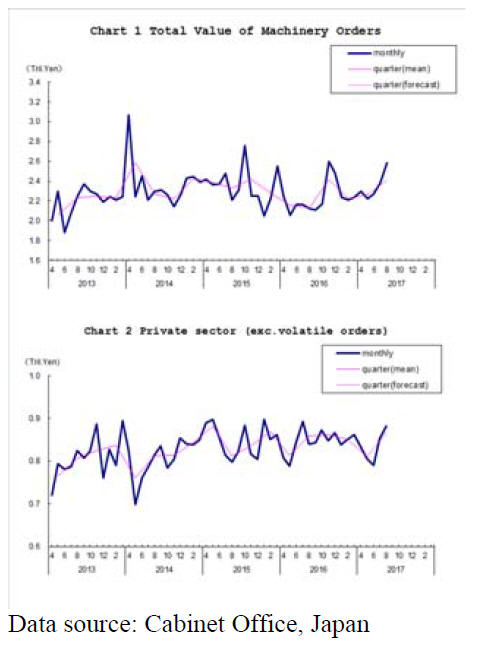
Faster growth driven by global demand
forecast
Along with the good news on corporate capital spending
the latest consumer confidence survey also delivered
positive news. The consumer sentiment index rose in
August, the latest for which data is available. The index
for overall livelihood also rose as did the income growth
index.
Of particular interest to wood product manufacturers was
the rise in the index assessing willingness to buy durable
goods.
In assessing recent economic trends the International
Monetary Fund has forecast Japan¡¯s economy will grow
1.5% this year, a figure slightly higher than forests three
months ago. This is because the global economic recovery
is moving at a faster pace than predicted driven by a strong
recovery in Europe, China, the United States and emerging
Asia.
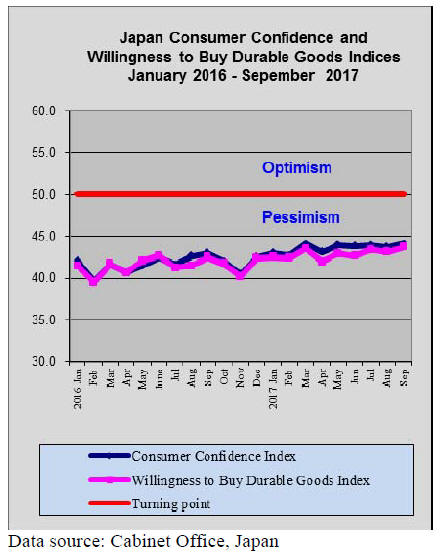
Yen exchange could be impacted by election
result
The uncertainty surrounding the outcome of Japan's
general election set for October 22 is impacting currency
markets.
In past elections the policies of the main political parties
were such that continuity was almost certain but in this
election things could be different.
A new party, Hope, led by the Tokyo Governor Yuriko
Koike, looks set to at least chip away some of the power of
the coalition that, except for a brief spell, has ruled Japan
for decades.
Under the current government the yen has been held in
check which has boosted exports, but if the new party
gains enough support to trim the ruling party¡¯s majority
then the basis for the yen's weakness may change.
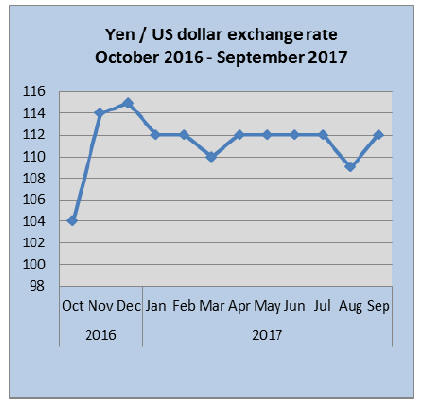
Experts see need for 1 million temporary
homes after
mega-quake
Next month the government¡¯s Central Disaster
Management Council will issue new guidelines for
alerting people of the expected Nankai Trough earthquake
that could claim hundreds of thousands of lives and
destroy thousands of buildings along a 700 km stretch of
Japan¡¯s southern and eastern coast including Tokyo.
A panel of experts has said that in the event of a Nankai
Trough earthquake up to 840,000 temporary housing units
would be required. Securing emergency accommodation
would be a major challenge in the event of a catastrophic
Nankai Trough quake.
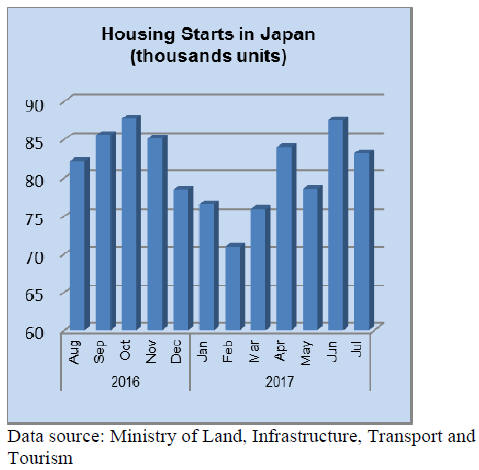
Import round up
Doors
The value of Japan¡¯s July imports of wooden doors (HS
441820) was little changed from the previous month and
data for August shows a 10% decline year on year with a
month on month fall of 18%.
In August the three main shippers, China, the Philippines
and Indonesia accounted for 86% of all imports of wooden
doors with China alone accounting for 56% of Japan¡¯s
total wooden door imports.
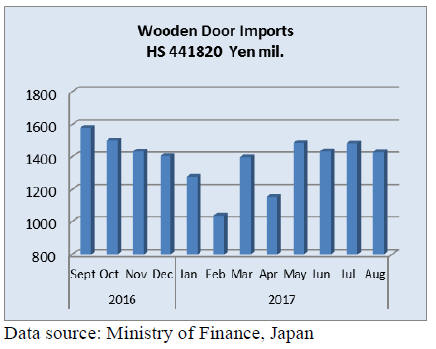
Windows
The steady decline in year on ear imports of wooden
windows into Japan continued into August. Year on year
August 2017 imports of HS441810 were down 27% and
compared to a month earlier August imports were down
18%.
As has been the trend over the year 3 countries dominate
Japan¡¯s imports of wooden windows, China (36%), the
Philippines (23%) and the US (30%). This leaves little
market share for other shippers mainly in Europe.

Assembled flooring
Once more the volatility in imports of assembled wooden
flooring (HS441871-79) observed this year continued into
August. Year on year, August imports were up over 60%
and compared to levels in July there was a 35% surge in
August imports.
The bulk of Japan¡¯s imports of assembled flooring fall
within HS 441875 which, in August, represented over
70% of imports.
Other major categories include HS 441879 (25%) shipped
mainly from China and Indonesia. Imports of HS 441873
and 79 are small (around 2% of August imports).

Plywood
Japan¡¯s August imports of plywood rose 11% year on year
but compared to a month earlier August import volumes
were flat.
Over the past 12 months shippers in Malaysia, mainly
Sarawak have provided the largest volume of plywood to
Japan. The second ranked shipper is Indonesia followed by
China. The three account for most of Japan¡¯s imported
plywood.
Shipments from Malaysia are mostly of HS 441231 (97%)
with small quantities of HS 4412 33 and 34. Shipments
from Indonesia follow a similar pattern with 87% being S
441231 but more HS 441234 is shipped (12%). In contrast
plywood shipments from China are more varied with HS
441231 accounting for 48%, HS441233 (31%), HS 4412
34 (8%) and HS441239 (12%).
 
Trade news from the Japan Lumber Reports (JLR)
For the JLR report please see:
http://www.nmokuzai.
com/modules/general/index.php?id=7
Tight supply of South Sea (Tropical) plywood
Shipments of ordered plywood of South Sea hardwood
have been largely delayed by log supply shortage.
Even after the rainy season was over, weather has not
improved in producing regions of Indonesia and Malaysia,
which hampers hauling of harvested logs to coast where
plywood mills are. Plywood mills operate with very little
log inventories. Also quality logs are hard to come by
now.
To produce thin plywood and floor base plywood, log
quality is important but the mills are not able to have
enough quality logs, which delayed production of ordered
volume. Delay of shipments is about three to four months
now and port inventories are way down in Japan while the
demand continues strong.
Because of supply shortage, the export prices are
climbing. Indonesian 2.4 mm thin plywood (second
class/F4 star) prices are US$800-820 per cbm C&F.
With supply shortage of imported plywood, demand of
thin plywood has been shifting to other materials such as
MDF and this move seems to accelerate.
Floor base plywood demand has been shifting to domestic
softwood plywood. Delayed shipments will continue as
the producing regions will be in rainy season again after
late October. Reduced supply volume and higher export
prices will continue.
Wood demand in 2016
Total demand for wood in 2016 was 78,077,000 cbms,
3.9% more than 2015. Housing starts were 6.4% more
than 2015, which stimulated wood demand for lumber and
plywood then with start-up of new biomass power
generation plants, demand of wood for fuel was additional.
The degree of self-sufficiency in wood increased by 1.6
points to 34.8% but for lumber, imports were more so that
the degree dropped by 0.7 points. The degree of wood for
fuel increased by 6.0 points with increased domestic
supply.
Domestic wood production for total demand was
27,141,000 cbms, 8.9% more then imports were
50,936,000 cbms, 1.4% more. Majority of domestic
increase was wood for fuel, which took 58.9% while wood
for lumber and plywood increased only by 2.6%.Domestic
wood for fuel was 4,458,000 cbms, which is more than
3,876,000 cbms for plywood and it is getting close to
5,266,000 cbms for pulp and wood chip.
Since there are more start-ups of biomass power
generation facilities in 2017, demand for wood for fuel
would be the second largest behind wood for lumber.
Domestic wood demand for plywood continues increasing
close to 4,000,000 cbms in 2017 since demand of domestic
plywood to replace floor base of South Sea hardwood
plywood.
Plywood
Demand for softwood plywood is brisk mainly by large
precutting plants while wholesale channels are getting
quiet after they have built up enough inventories. Medium
and small precutting plants maintain regular purchase
volume in fear of supply shortage they experienced a year
ago.
August softwood plywood production was high at
254,700 cbms, 10.8% more than August last year and
2.6% less than July despite fewer working days with the
Bon holidays.
The shipment in August was 249,900 cbms, 4.6% more
and 4.7% less. The inventories were 110,100 cbms, 7,300
cbms more than July.
Besides main product of structural plywood, plywood
mills now need to produce floor base panels for domestic
building manufacturers.
Trading firms are not able to respond to spotty orders
since volume allocation by plywood manufacturers is
unchanged. They are now trying to correct price gap
between direct buyers of precutting plans and wholesalers.
After plywood manufacturers increased the sales prices in
September, they are pushing the prices up step by step.
Imported 12 mm 2x6 coated concrete forming panel
supply is tight. The suppliers suffer log supply shortage to
manufacture veneer. Importers have enough inventory of
3x6 but 2x6 inventory is down with busy shipment.
Plywood conference by three countries
Plywood manufacturers and dealers from Indonesia,
Malaysia and Japan had conference at Jakarta, Indonesia
to exchange market information and trend of plywood
market.
The most recent issues are restriction of log harvest and
demand structure.
In Indonesia and Malaysia, harvest of natural growth
timber has reduced by various restrictions while
production of planted timber is increasing. In Indonesia,
40% of total harvest is now planted timber and in
Sarawak, Malaysia, share of planted timber in total harvest
will be more than 50%in five years.
In Sarawak, Malaysia, log production in the first half of
this year was 3,746,000 cbms out of which 2,937,000
cbms were naturally grown timber and 808,000 cbms were
planted timber, 21% in total harvest. Total year harvest of
planted timber this year will be 1,600,000 cbms, 300,000
cbms more than 2016.
Raw materials of various products are shifting from virgin
timber to planted timber.
In Indonesia, utilization of recyclable resources is
progressing and various products have been developed by
cooperation with the Japanese building materials
manufacturers.
To the question by Indonesia of present status of plywood
manufacturing in Japan with domestic wood resources, the
Japan Plywood Manufacturers Association answered that
the government has set target of six million cbms of
domestic logs for plywood manufacturing by 2025 and
eight million cbms for biomass power generation but it is
uncertain if this target is materialized.
It is the fact that domestic plywood is now more than
imported plywood in Japan but imported plywood is
absolutely necessary product for Japan but in coming
years, the market would not accept any product without
traceability or forest certificate.
Increasing consumption of CLT
Meeting by the governmental offices to promote use of
CLT was held recently and it reported that consumption of
CLT in 2017 would be about 20,000 cbms, four times
more than 2016 but gap between producing capacity of
about 60,000 cbms and actual consumption remains so
further promotion to use CLT is necessary.
In 2016, use of CLT was only 5,000 cbms to the
production of 50,000 cbms so the demand was only one
tenth of the production then in 2017, the production
increases to 60,000 cbms and the consumption increases to
20,000 cbms.
To promote use of CLT, the central and local governments
give subsidy so majority of CLT construction is based on
the subsidy. The government plans to increase the
production of CLT to 100,000 cbms by 2020 so further
demand promotion is immediate issue.
In 2017, total construction by CLT is 112, which exceeds
total CLT construction of 93 in the past so speed of
increase is remarkable but not enough to catch up the
production.
Since there are many buildings with subsidy, type of
buildings is public hall and community center by local
governments. Others are office, public housing,
companies¡¯ dormitory, stores and warehouse.
By the government¡¯s road map to stimulate use of CLT,
each local government has to build at least one CLT
building by 2018.
 
|